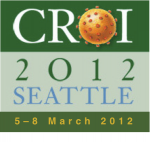Systolic blood pressure and risk of myocardial infarction in HIV infection
1 June 2012. Related: Conference reports, Coinfections and complications, CROI 19 (Retrovirus) 2012.
 Simon Collins, HIV i-Base
Simon Collins, HIV i-Base
A report from a large US observational cohort suggested that in HIV positive patients, increased systolic blood pressure (s-BP) may be a more significant risk for the risk of heart attack irrespective of use of hypertensive treatment, after controlling for other factors. [1]
This might support interventions to aim for lower target levels (<120), and certainly for ensuring that BP is routinely monitored (at least annually, as recommended in BHIVA guidelines).
Data was included from more than 84,000 patients in the Veterans Aging Cohort Study Virtual Cohort (VC) who were asymptomatic for cardiovascular disease at baseline. HIV positive patients were matched on age, gender, race and clinical site in a ratio of 1:2 to HIV negative patients. Clinical data were collected prospectively from 2003 to 2008.
During a median 4.6 years follow-up, there were 443 cases of acute myocardial infarction (AMI). Nearly half (47%) of these cases were in HIV positive patients.
After adjusting for age, race/ethnicity, diabetes, dyslipidaemia, smoking, hepatitis C, BMI, renal disease, cocaine and alcohol use hazard ratios (HR) for MI were significantly higher for HIV positive vs HIV negative groups for patients with pre-hypertension (S-BP 120-139) and controlled hypertension (s-BP <140 on BP treatment) as well as for people with hypertension (s-BP >140), see Table 1.
| S-PB (mmHg) category and BP treatment (Tx) | Hazard Ratio (95%CI) +ve vs –ve * |
|---|---|
| S-BP <120, no BP Tx | 1.14 (0.64-2.03) |
| S-BP 120-139 no BP Tx | 1,88 (1.19-2.99) |
| <140: + BP Tx | 3.11 (1.79-5.41) |
| >140 +/- BP Tx | 3.18 (1.99-5.07) |
* reference group is HIV-negative Veterans with S-BP <120.
comment
The major concern about this study is that no account was taken for ART which is strange given this was presented at CROI. This is important because some ARVs have been associated with BP in some studies and some ART drugs are also associated with a higher MI risk. It therefore remains unclear whether these results simply reflect the impact of ART.
Although the study can’t control for ART directly, as the HIV negative population won’t have received this, they could stratify the HIV positive group into those on ART and those not on ART.
References:
- Armah K et al. The impact of elevated and pre-hypertensive systolic blood pressure and the risk of acute myocardial infarction in HIV+ and HIV- veterans. Oral abstract 120.
http://retroconference.org/2012b/Abstracts/43509.htm - BHIVA monitoring guidelines.
http://www.bhiva.org

